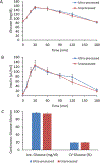Ultra-Processed Diets Cause Excess Calorie Intake and Weight Gain: An Inpatient Randomized Controlled Trial of Ad Libitum Food Intake
- PMID: 31105044
- PMCID: PMC7946062
- DOI: 10.1016/j.cmet.2019.05.008
Ultra-Processed Diets Cause Excess Calorie Intake and Weight Gain: An Inpatient Randomized Controlled Trial of Ad Libitum Food Intake
Erratum in
-
Ultra-Processed Diets Cause Excess Calorie Intake and Weight Gain: An Inpatient Randomized Controlled Trial of Ad Libitum Food Intake.Cell Metab. 2019 Jul 2;30(1):226. doi: 10.1016/j.cmet.2019.05.020. Cell Metab. 2019. PMID: 31269427 Free PMC article. No abstract available.
-
Ultra-Processed Diets Cause Excess Calorie Intake and Weight Gain: An Inpatient Randomized Controlled Trial of Ad Libitum Food Intake.Cell Metab. 2020 Oct 6;32(4):690. doi: 10.1016/j.cmet.2020.08.014. Cell Metab. 2020. PMID: 33027677 No abstract available.
Abstract
We investigated whether ultra-processed foods affect energy intake in 20 weight-stable adults, aged (mean ± SE) 31.2 ± 1.6 years and BMI = 27 ± 1.5 kg/m2. Subjects were admitted to the NIH Clinical Center and randomized to receive either ultra-processed or unprocessed diets for 2 weeks immediately followed by the alternate diet for 2 weeks. Meals were designed to be matched for presented calories, energy density, macronutrients, sugar, sodium, and fiber. Subjects were instructed to consume as much or as little as desired. Energy intake was greater during the ultra-processed diet (508 ± 106 kcal/day; p = 0.0001), with increased consumption of carbohydrate (280 ± 54 kcal/day; p < 0.0001) and fat (230 ± 53 kcal/day; p = 0.0004), but not protein (-2 ± 12 kcal/day; p = 0.85). Weight changes were highly correlated with energy intake (r = 0.8, p < 0.0001), with participants gaining 0.9 ± 0.3 kg (p = 0.009) during the ultra-processed diet and losing 0.9 ± 0.3 kg (p = 0.007) during the unprocessed diet. Limiting consumption of ultra-processed foods may be an effective strategy for obesity prevention and treatment.
Trial registration: ClinicalTrials.gov NCT03407053.
Keywords: diet quality; energy balance; energy intake; processed food; weight gain; weight loss.
Published by Elsevier Inc.
Conflict of interest statement
Declaration of Interests
CG Forde has received reimbursement for speaking at conferences sponsored by companies selling nutritional products, serves on the scientific advisory council for Kerry Taste and Nutrition, and is part of an academic consortium that has received research funding from Abbott Nutrition, Nestec, and Danone. The other authors have no conflicts of interest.
Figures




Comment in
-
Freshly Prepared Meals and Not Ultra-Processed Foods.Cell Metab. 2019 Jul 2;30(1):5-6. doi: 10.1016/j.cmet.2019.06.006. Epub 2019 Jun 20. Cell Metab. 2019. PMID: 31230986 No abstract available.
-
Ultra-Processed Food and Obesity: The Pitfalls of Extrapolation from Short Studies.Cell Metab. 2019 Jul 2;30(1):3-4. doi: 10.1016/j.cmet.2019.06.004. Epub 2019 Jun 20. Cell Metab. 2019. PMID: 31230987 No abstract available.
-
Challenges Interpreting Inpatient and Outpatient Human Nutrition Studies.Cell Metab. 2019 Aug 6;30(2):227-228. doi: 10.1016/j.cmet.2019.06.015. Epub 2019 Jul 1. Cell Metab. 2019. PMID: 31272848 No abstract available.
Similar articles
-
Associations between Consumption of Ultra-Processed Foods and Intake of Nutrients Related to Chronic Non-Communicable Diseases in Mexico.J Acad Nutr Diet. 2019 Nov;119(11):1852-1865. doi: 10.1016/j.jand.2019.04.020. Epub 2019 Jun 28. J Acad Nutr Diet. 2019. PMID: 31262695
-
Texture-based differences in eating rate influence energy intake for minimally processed and ultra-processed meals.Am J Clin Nutr. 2022 Jul 6;116(1):244-254. doi: 10.1093/ajcn/nqac068. Am J Clin Nutr. 2022. PMID: 35285882 Free PMC article. Clinical Trial.
-
Effect of a plant-based, low-fat diet versus an animal-based, ketogenic diet on ad libitum energy intake.Nat Med. 2021 Feb;27(2):344-353. doi: 10.1038/s41591-020-01209-1. Epub 2021 Jan 21. Nat Med. 2021. PMID: 33479499 Clinical Trial.
-
Dietary fiber and weight regulation.Nutr Rev. 2001 May;59(5):129-39. doi: 10.1111/j.1753-4887.2001.tb07001.x. Nutr Rev. 2001. PMID: 11396693 Review.
-
Beyond ultra-processed: considering the future role of food processing in human health.Proc Nutr Soc. 2023 Sep;82(3):406-418. doi: 10.1017/S0029665123003014. Epub 2023 Jun 1. Proc Nutr Soc. 2023. PMID: 37654079 Review.
Cited by
-
A Pilot Study Examining Stress and Obesity among Employees at a Historically Black College and University (HBCU): Does Job Satisfaction Matter?Ethn Dis. 2024 Oct 22;34(4):192-198. doi: 10.18865/EthnDis-2023-88. eCollection 2024 Oct. Ethn Dis. 2024. PMID: 39463814
-
Self-Initiated Dietary Adjustments Alter Microbiota Abundances: Implications for Perceived Health.Nutrients. 2024 Oct 18;16(20):3544. doi: 10.3390/nu16203544. Nutrients. 2024. PMID: 39458538 Free PMC article.
-
Validation of the Modified Yale Food Addiction Scale 2.0 (mYFAS 2.0) in Spanish University Students.Nutrients. 2024 Oct 15;16(20):3492. doi: 10.3390/nu16203492. Nutrients. 2024. PMID: 39458488 Free PMC article.
-
Defatted Flaxseed Flour as a New Ingredient for Foodstuffs: Comparative Analysis with Whole Flaxseeds and Updated Composition of Cold-Pressed Oil.Nutrients. 2024 Oct 14;16(20):3482. doi: 10.3390/nu16203482. Nutrients. 2024. PMID: 39458477 Free PMC article.
-
Dietary therapies interlinking with gut microbes toward human health: Past, present, and future.Imeta. 2024 Aug 10;3(5):e230. doi: 10.1002/imt2.230. eCollection 2024 Oct. Imeta. 2024. PMID: 39429878 Free PMC article.
References
-
- Baer DJ, Rumpler WV, Miles CW, and Fahey GC Jr. (1997). Dietary fiber decreases the metabolizable energy content and nutrient digestibility of mixed diets fed to humans. J Nutr 127, 579–586. - PubMed
-
- Black AE, and Cole TJ (2000). Within- and between-subject variation in energy expenditure measured by the doubly-labelled water technique: implications for validating reported dietary energy intake. Eur J Clin Nutr 54, 386–394. - PubMed
-
- Blatt H (2008). America’s food: What you don’t know about what you eat. (Cambridge: The MIT press; ).
Publication types
MeSH terms
Substances
Associated data
Grants and funding
LinkOut - more resources
Full Text Sources

